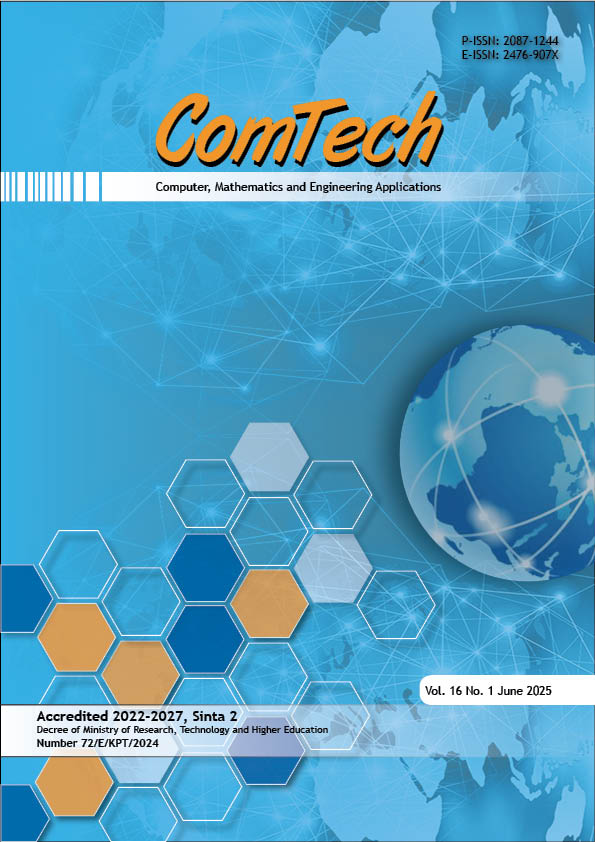Optimizing Quality Attributes of Piper Retrofractum Vahl. Through Partial Least Squares Regression: Insights from Pretreatment and Drying Experiments with Fruit Peel Infusions
DOI:
https://doi.org/10.21512/comtech.v16i1.12246Keywords:
Piper retrofractum Vahl., predictive modeling in food science, Partial Least Squares Regression (PLSR) , quality optimization in spice drying, sustainable food processing techniquesAbstract
The research aimed to optimize the quality attributes of Piper retrofractum Vahl.—piperine content, color brightness, and water content—using Partial Least Squares Regression (PLSR) to evaluate the pretreatment effects with fruit peel infusions and drying conditions. The research urgency lied in addressing the challenges of achieving consistent product quality while promoting sustainable food processing practices. Around 30 samples of Piper retrofractum Vahl. were subjected to varying pretreatment concentrations, soaking durations, drying durations, and peel types (orange and pineapple). The PLSR model was employed to identify key factors influencing the quality attributes and assess predictive performance based on Root Mean Squared Error (RMSE) and Coefficient of Determination (R²) values. As a result, the PLSR model explains 43.22% of the variance in piperine content, highlighting the importance of shorter soaking durations and higher pretreatment concentrations in preserving piperine levels. For water content, the model captures 75.08% of the variance, emphasizing the critical role of drying duration in reducing moisture. However, the color brightness model explains only 18.5% of the variance, indicating the need to explore contributing factors further. The research introduces the innovative use of fruit peel-infused water as a sustainable pretreatment method, contributing to eco-friendly food processing practices and offering practical insights into optimizing production for improved product quality. The findings underscore the importance of balancing pretreatment and drying parameters to address inconsistencies in quality while promoting sustainability. Future research should expand experimental conditions, integrate additional variables, and explore advanced modeling techniques to enhance predictive accuracy and product quality.
References
Amaliyah, S., Pangesti, D. P., Masruri, Sabarudin, A., & Sumitro, S. B. (2020). Green synthesis and characterization of copper nanoparticles using Piper Retrofractum Vahl extract as bioreductor and capping agent. Heliyon, 6(8), 1–12. https://doi.org/10.1016/j.heliyon.2020.e04636
Amaliyah, S., Sabarudin, A., Masruri, M., & Sumitro, S. B. (2022). Characterization and antibacterial application of biosynthesized silver nanoparticles using Piper Retrofractum Vahl fruit extract as bioreductor. Journal of Applied Pharmaceutical Science, 12(3), 103–114. https://doi.org/10.7324/japs.2022.120311
Andrade, C. B., Moura-Bueno, J. M., Comin, J. J., & Brunetto, G. (2023). Grape yield prediction models: Approaching different machine learning algorithms. Horticulturae, 9(12), 1–18. https://doi.org/10.3390/horticulturae9121294
Aymen, S., Nawaz, H., Majeed, M. I., Rashid, N., Ehsan, U., Shahzad, R., ... & Ali, Z. (2023). Raman spectroscopy for the quantitative analysis of Lornoxicam in solid dosage forms. Journal of Raman Spectroscopy, 54(3), 250–257. https://doi.org/10.1002/jrs.6476
Christianty, F. M., Dewi, A. S., Khasanah, F., Holidah, D., Dewi, I. P., & Fajrin, F. A. (2024). Drug-Piperaceae herb interaction potency through analgesic, anxiolytic, and antiinflammatory activity studies. Tropical Journal of Natural Product Research, 8(4), 6781–6786. https://doi.org/10.26538/tjnpr/v8i4.6
Dermawan, I. G. N. P., Sari, N. N. G., & Ardana, D. Y. (2022). The role of Java cabe (Piper Retrofractum Vahl.) on traumatic ulcer treatment: Peran cabe Jawa (Piper Retrofractum Vahl.) dalam menanggulangi ulkus traumatikus. Interdental Jurnal Kedokteran Gigi (IJKG), 18(2), 74–80.
Ekowati, H., Achmad, A., Prasasti, E., Wasito, H., Sri, K., Hidayati, Z., & Ekasari, T. (2012). Zingiber Officinale, Piper Retrofractum and combination induced apoptosis and p53 expression in Myeloma and WiDr cell lines. HAYATI Journal of Biosciences, 19(3), 137–140. https://doi.org/10.4308/hjb.19.3.137
Gorgani, L., Mohammadi, M., Najafpour, G. D., & Nikzad, M. (2017). Piperine—The bioactive compound of black pepper: From isolation to medicinal formulations. Comprehensive Reviews in Food Science and Food Safety, 16(1), 124–140. https://doi.org/10.1111/1541-4337.12246
Greenberg, I., Sawallisch, A., Stelling, J., Vohland, M., & Ludwig, B. (2023). Optimization of sample preparation and data evaluation techniques for X-ray fluorescence prediction of soil texture, pH, and cation exchange capacity of loess soils. Soil Science Society of America Journal, 88(1), 27–42. https://doi.org/10.1002/saj2.20598
Ishii, M., Miyata, H., Ikeda, N., Tagawa, T., & Nishimura, M. (2022). Piper retrofractum extract and its component piperine promote lymphangiogenesis via an AKT‐ and ERK‐dependent mechanism. Journal of Food Biochemistry, 46(9), 1–13. https://doi.org/10.1111/jfbc.14233
Jin, J., Wu, M., Song, G., & Wang, Q. (2022). Genetic algorithm captured the informative bands for partial least squares regression better on retrieving leaf nitrogen from hyperspectral reflectance. Remote Sensing, 14(20), 1–18. https://doi.org/10.3390/rs14205204
Khudzaifi, M., Retno, S. S., & Rohman, A. (2020). The employment of FTIR spectroscopy and chemometrics for authentication of essential oil of Curcuma mangga from candle nut oil. Food Research, 4(2), 515–521. https://doi.org/10.26656/fr.2017.4(2).313
Kubo, M., Ishii, R., Ishino, Y., Harada, K., Matsui, N., Akagi, M., ... & Fukuyama, Y. (2013). Evaluation of constituents of Piper Retrofractum fruits on neurotrophic activity. Journal of Natural Products, 76(4), 769–773. https://doi.org/10.1021/np300911b
Li, Y. Y., Liu, Y., Ranagalage, M., Zhang, H., & Zhou, R. (2020). Examining land use/land cover change and the summertime surface urban heat island effect in fast-growing Greater Hefei, China: Implications for sustainable land development. ISPRS International Journal of Geo-Information, 9(10), 1–18. https://doi.org/10.3390/ijgi9100568
Liu, W., Zhang, B., Xin, Z., Ren, D., & Yi, L. (2017). GC-MS fingerprinting combined with chemometric methods reveals key bioactive components in Acori Tatarinowii Rhizoma. International Journal of Molecular Sciences, 18(7), 1–11. https://doi.org/10.3390/ijms18071342
Mao, Q., Wu, Z., Deng, Y., Sun, J., Bai, H., Gong, L., & Jiang, Z. (2023). Assessing the “scale of effect”: The impact of multi-scale landscape characteristics on urban bird species taxonomic and functional diversity. Diversity, 15(8), 1–19. https://doi.org/10.3390/d15080943
Meechuen, M., Pimsawang, L., Chaisan, T., Samipak, S., Pluempanupat, W., & Juntawong, P. (2023). Comparative transcriptome analysis reveals genes associated with alkaloid diversity in Javanese long pepper (Piper Retrofractum) fruits. International Journal of Plant Biology, 14(4), 896–909. https://doi.org/10.3390/ijpb14040066
Munnaf, M. A., & Mouazen, A. M. (2022). Removal of external influences from on-line vis-NIR spectra for predicting soil organic carbon using machine learning. CATENA, 211. https://doi.org/10.1016/j.catena.2022.106015
Nurhidayah, E. S., Hidayati, D., Habiba, R. A., & Maulidya, S. (2024). Molecular docking and ADMET studies to investigate antioxidant potency of new amides of Piper Retrofractum Vahl. By targeting Keap1 inhibitor. In IOP Conference Series Earth and Environmental Science (Vol. 1358). https://doi.org/10.1088/1755-1315/1358/1/012003
Oe, M., Wada, K., Asikin, Y., Arakaki, M., Horiuchi, M., & Takahashi, M. (2023). Effects of processing methods on the aroma constituents of hihatsumodoki (Piper Retrofractum Vahl.). Journal of Food Science, 88(6), 2463–2477. https://doi.org/10.1111/1750-3841.16606
Panphut, W., Budsabun, T., & Sangsuriya, P. (2020). In vitro antimicrobial activity of Piper Retrofractum fruit extracts against microbial pathogens causing infections in human and animals. International Journal of Microbiology, 2020(1), 1–6. https://doi.org/10.1155/2020/5638961
Rimsha, G., Shahbaz, M., Majeed, M. I., Nawaz, H., Rashid, N., Akram, M. W., ... & Imran, M. (2023). Raman spectroscopy for the quantitative analysis of solid dosage forms of the active pharmaceutical ingredient of Febuxostat. ACS Omega, 8(44), 41451–41457. https://doi.org/10.1021/acsomega.3c05243
Rohmatulloh, B., Lee, M. N., Alatiffa, R. M., Megatama, R. P., Napitupulu, R. A. C., Hendrawan, Y., & Lutfi, M. (2022). Non-destructive prediction of piperine in Javanese chilli (Piper Retrofractum Vahl.) based on color and texture analysis using artificial neural network. In IOP Conference Series Earth and Environmental Science (Vol. 1083). https://doi.org/10.1088/1755-1315/1083/1/012040
Salehi, F. (2020). Recent applications and potential of infrared dryer systems for drying various agricultural products: A review. International Journal of Fruit Science, 20(3), 586–602. https://doi.org/10.1080/15538362.2019.1616243
Salter, I. (2018). Seasonal variability in the persistence of dissolved environmental DNA (eDNA) in a marine system: The role of microbial nutrient limitation. PLOS ONE, 13(2), 1–23. https://doi.org/10.1371/journal.pone.0192409
Sim, S. F., Chai, M. X. L., & Kimura, A. L. J. (2018). Prediction of lard in palm olein oil using Simple Linear Regression (SLR), Multiple Linear Regression (MLR), and Partial Least Squares Regression (PLSR) based on Fourier‐Transform Infrared (FTIR). Journal of Chemistry, 2018(1), 1–8.
Stark, J., Hiersche, K. J., Yu, J. C., Hasselbach, A. N., Abdi, H., & Hayes, S. M. (2023). Partial least squares regression analysis of alzheimer’s disease biomarkers, modifiable health variables, and cognitive change in older adults with mild cognitive impairment. Journal of Alzheimer’s Disease, 93(2), 633–651. https://doi.org/10.3233/jad-221084
Supriyanto, & Mojiono. (2022). Inhibition of main protease enzyme (Mpro) by active compounds in cabya (Piper Retrofractum Vahl.) for COVID-19 treatment via in silico experiment. In IOP Conference Series: Earth and Environmental Science (Vol. 1059). https://doi.org/10.1088/1755-1315/1059/1/012047
Takahashi, M., Ohshiro, M., Ohno, S., Yonamine, K., Arakaki, M., & Wada, K. (2018). Effects of solar- and oven-drying on physicochemical and antioxidant characteristics of hihatsumodoki (Piper Retrofractum Vahl) fruit. Journal of Food Processing and Preservation, 42(2). https://doi.org/10.1111/jfpp.13469
Tang, R., Zhang, Y. Q., Hu, D. B., Yang, X. F., Yang, J., San, M. M., ... & Wang, Y. H. (2019). New amides and phenylpropanoid glucosides from the fruits of Piper Retrofractum. Natural Products and Bioprospecting, 9, 231–241. https://doi.org/10.1007/s13659-019-0208-z
Thelwell, M., Bullas, A., Kuhnapfel, A., Hart, J., Ahnert, P., Wheat, J., Loeffler, M., Scholz, M., & Choppin, S. (2020). Allometry between measures of body size and shape in a large population-based cohort. In Proceedings of 3DBODY.TECH 2020 11th International Conference and Exhibition on 3D Body Scanning and Processing Technologies.
Tsalyuk, M., Kelly, M., & Getz, W. M. (2017). Improving the prediction of African savanna vegetation variables using time series of MODIS products. ISPRS Journal of Photogrammetry and Remote Sensing, 131, 77–91. https://doi.org/10.1016/j.isprsjprs.2017.07.012
Vannabhum, M., Ziangchin, N., Thepnorarat, P., & Akarasereenont, P. (2023). Metabolomic analysis of Thai Herbal Analgesic Formula based on ultra-high-performance liquid chromatography-quadrupole time-of-flight mass spectrometry. Heliyon, 9(7), 1–11. https://doi.org/10.1016/j.heliyon.2023.e18296
Wan, Y., Yuan, X., Liu, J., Zhang, D., Zhang, Z., & Sha, M. (2023). Efficient determination of pesticides in rice by QuEChERS and UV spectroscopy in combination with chemometrics. Cereal Chemistry, 100(5), 1106–1113. https://doi.org/10.1002/cche.10692
Weil, M., Sing, A. S. C., Méot, J. M., Boulanger, R., & Bohuon, P. (2017). Impact of blanching, sweating and drying operations on pungency, aroma and color of Piper Borbonense. Food Chemistry, 2019, 274–281. https://doi.org/10.1016/j.foodchem.2016.09.144
Yeo, W. S., & Saptoro, A. (2024). Introduction of LSSVR for the prediction of the yellowness index. International Journal of Computing and Digital Systems, 15(1), 81–90. https://doi.org/10.12785/ijcds/150107
Zhang, Z. Y., Wang, Y. J., Yan, H., Chang, X. W., Zhou, G. S., Zhu, L., ... & Duan, J. A. (2021). Rapid geographical origin identification and quality assessment of Angelicae Sinensis Radix by FT-NIR spectroscopy. Journal of Analytical Methods in Chemistry, 2021(1), 1–12. https://doi.org/10.1155/2021/8875876
Zhou, J., Yungbluth, D., Vong, C. N., Scaboo, A., & Zhou, J. (2019). Estimation of the maturity date of soybean breeding lines using UAV-based multispectral imagery. Remote Sensing, 11(18), 1–17. https://doi.org/10.3390/rs11182075
Downloads
Published
How to Cite
Issue
Section
License
Copyright (c) 2025 Ida Lumintu

This work is licensed under a Creative Commons Attribution-ShareAlike 4.0 International License.
Authors who publish with this journal agree to the following terms:
a. Authors retain copyright and grant the journal right of first publication with the work simultaneously licensed under a Creative Commons Attribution License - Share Alike that allows others to share the work with an acknowledgment of the work's authorship and initial publication in this journal.
b. Authors are able to enter into separate, additional contractual arrangements for the non-exclusive distribution of the journal's published version of the work (e.g., post it to an institutional repository or publish it in a book), with an acknowledgment of its initial publication in this journal.
c. Authors are permitted and encouraged to post their work online (e.g., in institutional repositories or on their website) prior to and during the submission process, as it can lead to productive exchanges, as well as earlier and greater citation of published work.
 USER RIGHTS
 All articles published Open Access will be immediately and permanently free for everyone to read and download. We are continuously working with our author communities to select the best choice of license options, currently being defined for this journal as follows:




















